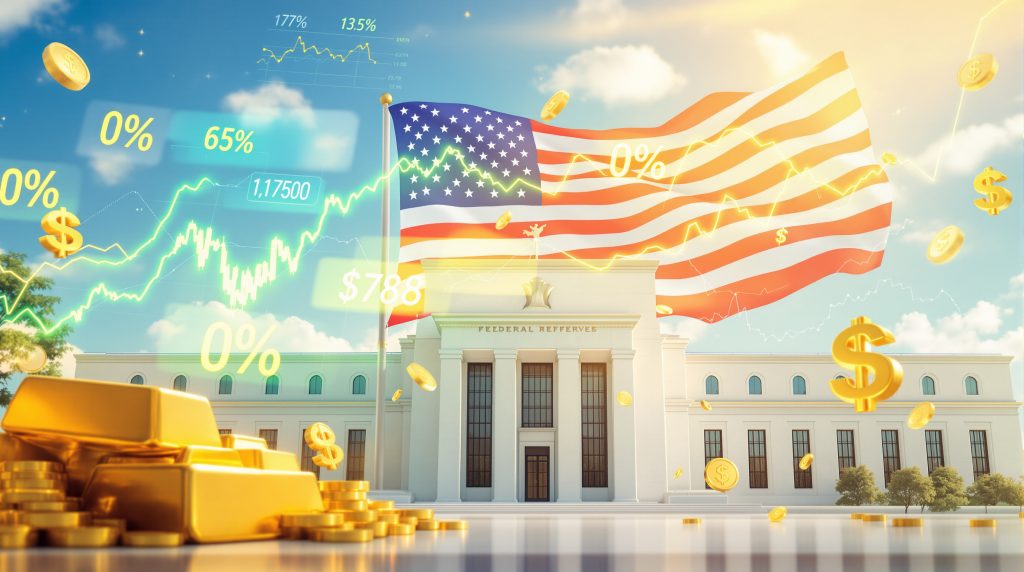The relationship between Federal Reserve rate cuts and gold prices represents one of the most closely watched dynamics in financial markets. When the Fed adjusts its benchmark interest rate, precious metals investors typically respond with heightened attention, as these policy shifts can dramatically alter gold's investment appeal across global markets. Furthermore, comprehensive gold price analysis reveals significant patterns during monetary policy transitions.
What Makes Gold React to Federal Reserve Decisions?
The Opportunity Cost Mechanism
Lower interest rates fundamentally reduce the attractiveness of yield-bearing alternatives to gold ownership. When the Federal Reserve cuts rates, treasury bonds, certificates of deposit, and high-yield savings accounts offer diminished returns, making non-yielding assets like gold more compelling by comparison.
Consider the practical impact: when 10-year Treasury yields drop from 4.5% to 2.0%, the opportunity cost of holding gold decreases substantially. Investors no longer sacrifice significant income potential by allocating portfolio space to precious metals, as traditional safe haven assets provide less compensation for capital deployment.
This mechanism becomes particularly pronounced during periods of aggressive rate cutting. The 2019-2020 cycle demonstrated this principle clearly, as the Fed reduced rates from 2.5% to 0.25% while gold prices surged 28% over 12 months, according to Federal Reserve Economic Data and precious metals market analysis.
Real Interest Rate Calculations
Real interest rates, calculated as nominal rates minus inflation expectations, provide crucial insight into gold's fundamental value proposition. When real rates turn negative, gold historically experiences substantial demand increases as investors seek inflation protection.
The formula appears straightforward: Real Rate = Nominal Interest Rate – Inflation Rate. However, market participants must consider both current inflation readings and forward-looking expectations embedded in Treasury Inflation-Protected Securities (TIPS) breakeven rates.
During periods when inflation runs at 3.2% while the federal funds rate sits at 2.5%, real rates become negative at -0.7%. These conditions historically correlate with increased institutional and retail gold accumulation, as investors recognise the erosion of purchasing power in cash-equivalent positions.
Why Do Rate Cuts Typically Boost Gold Demand?
Safe Haven Asset Characteristics
Gold's performance during Federal Reserve easing cycles reflects its fundamental role as a portfolio diversifier during economic uncertainty. Historical analysis reveals consistent patterns of precious metals outperformance when central banks implement accommodative monetary policies. In addition, understanding the gold‐stock market relationship becomes crucial during these periods.
The 2000-2001 dot-com recession period illustrates this dynamic effectively. As the Fed reduced rates from 6.5% to 1% over 24 months, gold prices gained 26%, providing portfolio protection while equity markets declined substantially. Similar patterns emerged during the 2007-2008 financial crisis, when gold appreciated 39% as rates fell from 5.25% to 0.25%.
Comparative analysis against other safe haven assets reveals gold's unique positioning:
• Government bonds: Provide yield but face duration risk during rate cycles
• Swiss franc: Offers currency stability but limited upside potential
• Japanese yen: Traditional safe haven with intervention risks
• Gold: No counterparty risk, inflation hedge, and historical crisis performance
Currency Debasement Concerns
Expansionary monetary policy inevitably raises questions about currency purchasing power over extended timeframes. When the Federal Reserve increases money supply through rate cuts and quantitative easing programmes, international investors frequently seek alternatives to dollar-denominated assets.
Central bank purchasing patterns during easing cycles demonstrate this principle. According to World Gold Council data, official sector purchases typically accelerate when major economies implement accommodative policies. Russia, China, and Turkey significantly increased gold reserves during the 2019-2020 period, coinciding with global rate cutting cycles.
The dollar's role as global reserve currency creates additional complexity. International holders of dollar reserves face implicit taxation through monetary expansion, driving diversification into hard assets. This dynamic becomes self-reinforcing as increased gold demand supports higher prices, validating the initial investment thesis.
What Does Recent Fed Policy Tell Us About Gold's Future?
Current Rate Environment Analysis
The Federal Reserve's recent policy trajectory provides important context for precious metals positioning. Following the aggressive tightening cycle that brought rates to 5.25-5.5% by mid-2023, market participants closely monitor signals regarding future policy direction. Moreover, the current gold market surge reflects these evolving conditions.
Current market conditions reflect several competing factors:
• Inflation persistence: Core PCE remaining above Fed targets despite rate increases
• Labour market resilience: Employment data suggesting continued economic strength
• Financial stability concerns: Banking sector stress and credit tightening effects
• Global economic uncertainty: Geopolitical tensions and trade policy implications
Fed Chair Jerome Powell's recent communications emphasise data dependency in future decisions. The central bank's dual mandate requires balancing employment objectives against price stability goals, creating potential policy conflicts during transitional economic periods.
Economic Data Dependencies
Federal Reserve decision-making increasingly depends on real-time economic indicators, creating volatility in gold prices and Federal Reserve rate cuts around key data releases. Employment reports, inflation readings, and GDP growth figures all influence rate expectations and corresponding precious metals demand.
Recent government operational challenges have complicated economic visibility for both policymakers and investors. Limited data availability during administrative transitions creates uncertainty about underlying economic conditions, potentially leading to more cautious Federal Reserve positioning.
Market pricing of future rate expectations, reflected in fed funds futures contracts, shows significant volatility around major economic announcements. This sensitivity translates directly into gold price movements, as investors adjust precious metals exposure based on evolving policy probabilities.
How Have Gold Prices Responded to Historical Rate Cuts?
Previous Easing Cycle Performance
| Fed Easing Period | Rate Cut Magnitude | Gold Price Response | Time Frame |
|---|---|---|---|
| 2000-2001 | 6.5% to 1% | +26% gain | 24 months |
| 2007-2008 | 5.25% to 0.25% | +39% gain | 18 months |
| 2019-2020 | 2.5% to 0.25% | +28% gain | 12 months |
These historical precedents demonstrate consistent patterns in gold's response to accommodative monetary policy. However, each cycle occurred within unique economic contexts that influenced both the magnitude and timing of precious metals performance.
The 2000-2001 period coincided with equity market corrections and economic recession, amplifying gold's safe haven appeal. The 2007-2008 cycle occurred during systemic financial crisis, creating extraordinary demand for non-counterparty assets. The 2019-2020 experience reflected pandemic-related economic disruption and unprecedented fiscal policy responses.
Pattern Recognition in Gold Markets
Analysing intraday and weekly trading patterns reveals important insights about gold market behaviour during Federal Reserve announcement periods. Volatility typically increases substantially in the 24-48 hours surrounding policy decisions, creating both opportunities and risks for active traders.
Institutional versus retail investor behaviour shows distinct differences during rate cut cycles. Large asset managers often position defensively ahead of expected policy changes, whilst individual investors frequently respond reactively to actual announcements and subsequent market movements.
Volume analysis indicates that significant gold price movements during Fed policy cycles often require confirmation through sustained trading activity. Initial reactions to rate cut announcements sometimes reverse within days if underlying economic conditions don't support continued precious metals demand.
What Other Factors Influence Gold During Rate Cut Cycles?
Geopolitical Risk Premium
Trade tensions between major economies can significantly amplify gold's response to Federal Reserve policy changes. When rate cuts coincide with international economic conflicts, precious metals often experience enhanced safe haven demand beyond what monetary policy alone would generate.
Current analysis suggests that ongoing trade policy uncertainty creates additional support for gold prices and Federal Reserve rate cuts. Investors recognise that currency wars and competitive devaluations often accompany trade disputes, making hard assets more attractive as portfolio diversifiers.
Military conflicts and regional instability provide another layer of support for precious metals during accommodative monetary policy periods. The combination of currency debasement concerns and geopolitical uncertainty creates powerful fundamental drivers for gold demand across both institutional and retail investor segments.
Inflation Expectations Management
Market-based inflation expectations, measured through TIPS breakeven rates and inflation swap contracts, provide real-time insight into investor sentiment regarding future price pressures. These indicators often move independently of current inflation readings, creating opportunities for gold positioning ahead of policy shifts.
Consumer versus producer price pressures reveal different aspects of inflationary dynamics that influence Federal Reserve decision-making. Supply chain disruptions, energy price volatility, and labour market tightness all contribute to complex inflation patterns that affect precious metals demand.
Furthermore, Reuters analysis indicates that international factors increasingly influence domestic monetary policy decisions and corresponding gold market reactions.
"The relationship between Federal Reserve policy and gold prices becomes most pronounced when rate cuts coincide with rising inflation expectations, creating negative real interest rates that historically drive substantial precious metals outperformance."
Should Investors Position for Rate Cut Scenarios?
Portfolio Allocation Strategies
Defensive positioning during uncertain Federal Reserve policy periods requires careful consideration of risk-adjusted return expectations and correlation patterns across asset classes. Gold's low correlation with equities and bonds makes it valuable for portfolio diversification, particularly during monetary policy transitions.
Professional portfolio managers often distinguish between physical gold exposure and gold mining equity positions during rate cut cycles. Mining stocks provide leveraged exposure to gold price movements but carry additional operational and financial risks that may not align with defensive investment objectives.
Strategic allocation frameworks typically suggest 5-10% precious metals exposure for conservative portfolios, with higher allocations during periods of monetary policy uncertainty. However, individual circumstances, risk tolerance, and investment timeframes should guide specific positioning decisions. Additionally, the gold price forecast provides valuable insights for long-term planning.
Timing Considerations
Dollar-cost averaging into gold positions can reduce timing risks associated with Federal Reserve policy anticipation. Rather than attempting to predict specific rate cut announcements, systematic accumulation allows investors to benefit from precious metals' long-term monetary policy relationships without short-term trading pressures.
Volatility patterns around Fed announcement dates create both opportunities and risks for tactical positioning. Historical analysis shows increased price swings in the 72 hours surrounding Federal Open Market Committee meetings, suggesting careful entry and exit timing can enhance returns for active traders.
Seasonal factors in precious metals markets add another dimension to timing considerations. Traditional patterns show increased gold demand during September-February periods, potentially amplifying Federal Reserve policy impacts during these months.
What Are the Risks to the Gold-Rate Cut Relationship?
Market Structure Changes
Exchange-traded fund flows have fundamentally altered gold price discovery mechanisms over the past decade. Large ETF redemptions or creations can overwhelm traditional supply-demand relationships, potentially disrupting historical correlations between Federal Reserve policy and precious metals performance.
Algorithmic trading systems increasingly dominate short-term gold price movements, responding to Federal Reserve communications and economic data releases within microseconds. This technological evolution may create more extreme price reactions to policy changes whilst reducing sustained trend movements that historically characterised precious metals markets.
Central bank digital currency development represents a long-term structural risk to gold's monetary role. As governments implement digital alternatives to physical currency, some traditional demand drivers for precious metals may diminish, although implementation timelines remain uncertain.
Economic Scenario Planning
Stagflation scenarios, combining economic stagnation with persistent inflation, historically favour precious metals performance regardless of Federal Reserve policy responses. However, modern central bank tools and communication strategies may alter traditional relationships between monetary policy and gold demand.
Deflationary spirals present complex challenges for gold positioning during rate cut cycles. Whilst lower rates reduce opportunity costs, deflation can suppress commodity prices generally, creating competing forces that complicate investment decisions.
Growth acceleration scenarios that reduce Federal Reserve cutting pressure could limit gold's upside potential despite accommodative policy. Strong economic performance may encourage risk asset allocation away from defensive positions, even when monetary policy remains supportive.
Navigating Gold Investment in a Changing Rate Environment
Strategic Takeaways for Investors
Long-term precious metals positioning benefits from understanding Federal Reserve policy cycles whilst avoiding short-term trading based solely on rate cut speculation. Historical patterns provide guidance, but each economic environment presents unique characteristics that require careful analysis and flexible positioning strategies. Consequently, the current gold market outlook reflects these evolving dynamics.
Risk-adjusted return expectations during easing cycles should account for gold's volatility characteristics and correlation patterns with other asset classes. Whilst precious metals often outperform during accommodative monetary policy periods, investors must balance potential returns against overall portfolio risk and liquidity requirements.
Integration with broader portfolio diversification goals remains essential for successful precious metals investing. Gold's role as a monetary hedge and crisis asset should complement, rather than replace, comprehensive investment strategies that address multiple economic scenarios and risk factors.
The evolving relationship between gold prices and Federal Reserve rate cuts continues to provide opportunities for informed investors who understand both historical patterns and changing market dynamics. Success requires patience, discipline, and recognition that monetary policy represents just one factor among many that influence precious metals performance over time.
Disclaimer: This analysis is for educational purposes only and should not be considered investment advice. Precious metals investments carry risks including price volatility, storage costs, and market liquidity considerations. Past performance does not guarantee future results, and investors should conduct thorough research or consult financial professionals before making investment decisions.
Ready to Capitalise on Gold Market Opportunities?
Discovery Alert provides instant notifications on significant ASX mineral discoveries, powered by its proprietary Discovery IQ model, helping investors identify actionable opportunities in precious metals and mining sectors ahead of broader market movements. Begin your 30-day free trial today to gain real-time insights into gold mining discoveries and secure your market-leading advantage in this dynamic sector.




